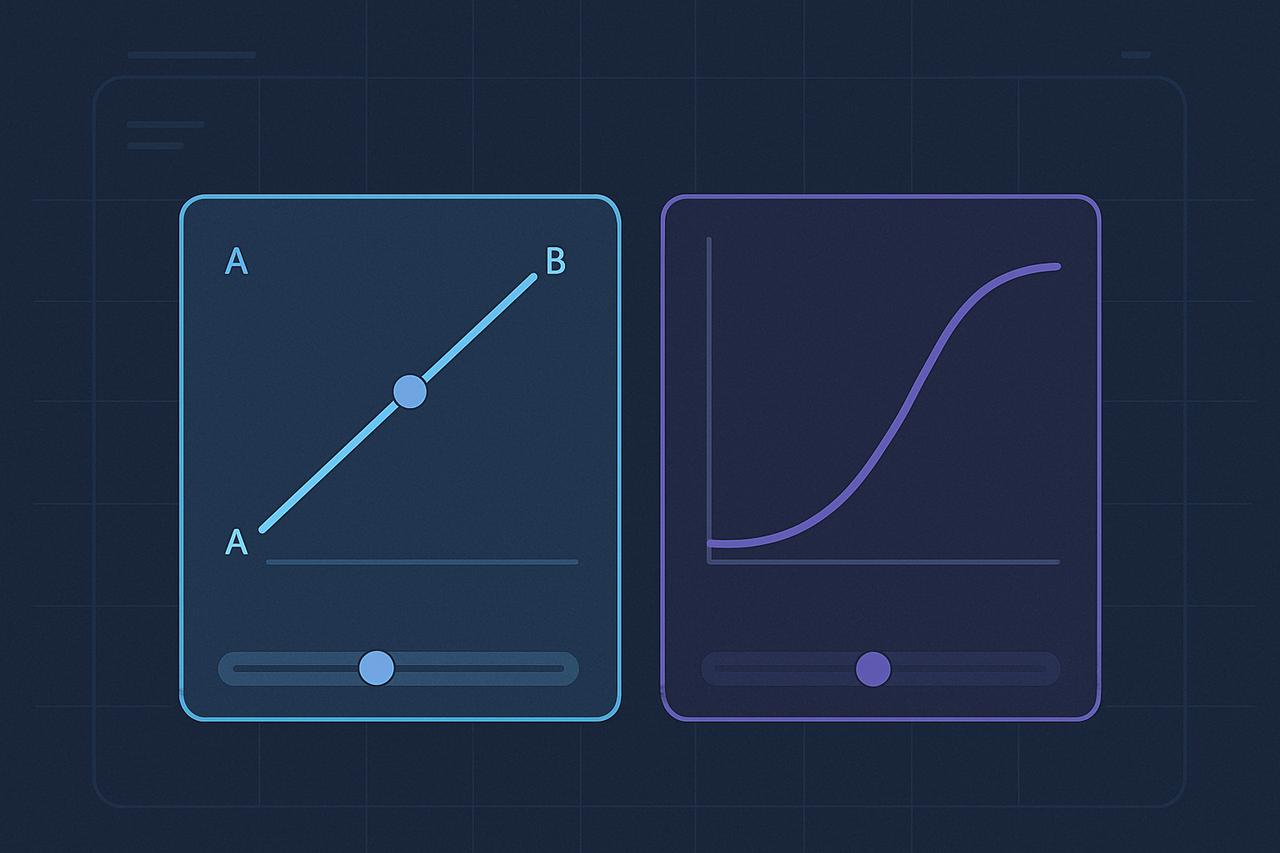If you work with animations, games, or UI transitions, you've probably heard of lerp() and easing functions. But when do you use which? Let's unravel these powerful techniques.
What is a Lerp?
Lerp stands for Linear Interpolation. It's a mathematical technique to calculate a value between two points based on a ratio (t). Simply put: "Give me a point that is X% of the way from A to B."
function lerp(start, end, t) {
return start + (end - start) * t;
}
// Output: 0.5 (exactly halfway)
console.log(lerp(0, 1, 0.5));
What is Easing?
Easing controls how an animation accelerates or decelerates. Instead of linear motion (lerp), you can create more natural effects like speeding up, slowing down, or bouncing.
function easeOutQuad(t) {
return 1 - (1 - t) * (1 - t);
}
// Output: 0.75 (not halfway, it has eased)
console.log(easeOutQuad(0.5));
What is Lerp Perfect For?
It's great for things like color transitions. If you have a value between 0 and 1, you can create a gradient by lerping the r, g, and b values:
function colorLerp(color1, color2, t) {
return {
r: lerp(color1.r, color2.r, t),
g: lerp(color1.g, color2.g, t),
b: lerp(color1.b, color2.b, t)
};
}
// Example
const red = { r: 1, g: 0, b: 0 };
const blue = { r: 0, g: 0, b: 1 };
const purple = colorLerp(red, blue, 0.5);
console.log(purple); // { r: 0.5, g: 0, b: 0.5 }
The problem with lerp() in an update loop
It looks elegant to create a smooth animation with a single line, but it can cause problems.
A lerp() takes a fraction of the distance between a start and end value, which means it will never reach the end (a mathematical asymptote). This means you have no control over the duration of your animation.
Imagine you have an update method that you run every frame:
function animate() {
box.style.top = lerp(current, target, 0.1) + 'px';
requestAnimationFrame(animate);
}
animate();
Here you can see that while scrolling, the value never reaches the final number. This can have performance implications; in this case, the element continues to animate even when it should be stationary.
The easiest solution for this is to round the number before applying it. In the background, the current value is still the same, but the applied value reaches the final number thanks to rounding.
If we want to fix the fundamental problem, we can no longer use a fraction into infinity. The solution: a fixed animation duration. To work with a fixed duration, we need to:
- Start an animation with
requestAnimationFrameon every scroll. - Stop the previous animation if it exists with
cancelAnimationFrame. - Keep track of the time for the duration with
performance.now(). - Determine the duration based on the distance and speed.
- Set a minimum and maximum duration.
Great, it works, we have a lot of control over the animation, but it's definitely not as smooth as the lerp() from before. What now?
This is where easing comes into play.
- Instead of a
lerp(), we use theeaseOutQuint()easing function on theprogressvariable. - We multiply this
easedToutput by the difference between the end and start positions.
That's it!
On easings.net, you can try out all sorts of easings to see which one you like best by replacing easeOutQuint().
Conclusion
Lerp and easing are both powerful tools for animation, but they each have their own applications and limitations.
Lerp is ideal for simple, linear interpolations like color transitions, while easing provides more natural movements that accelerate and decelerate over a fixed duration.
It's important to choose the right technique based on your needs and to be aware of lerp's limitations, such as its asymptotic behavior. By combining both techniques, you can create animations that are both smooth and controlled, giving your projects a professional look and feel.




